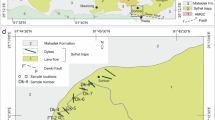Abstract
The paper embodies the field, petrographic and petrochemical studies of the dykes occuring within the Deccan basalts, in the Western portions of Rajpipla hills. Major and minor dykes with different trends occur in the area varying in thickness from 2′ to 75′ and traceable lengthwise from few to several miles. The density of the dyke distribution is two per mile.
The composition of the minor dykes ranges from teschenite to trachyte with dominant basaltic types and they seem to be coeval with the flows of the area. The major dolerite dykes are found to be post-lava.
Both alkali-olivine basalt and tholeiitic types occur. The former phase preceeds the latter and includes the minor alkaline dykes. A differentiation trend based on new chemical analyses is proposed.
Similar content being viewed by others
References
Auden, J. B., 1949,Dykes in Western India. A discussion of their relationship with Deccan Traps. Trans. Nat. Inst. Sci. Ind.,III, No. 3, p. 123–157.
Blanford, W. T., 1869,On the Geology of the Taptee and lower Narmada valleys and some adjoining districts. Mem. Geol. Surv. Ind.,6, p. 56, 58, 163 and 189.
Bose, P. N., 1909,Notes on the geology and mineral resources of the Rajpipla state. Rec. Geol. Surv. Ind.,37, p. 167–190.
Edwards, A. B., 1938,Tertiary lavas from the Kergulen archipelago. B.A.N.Z. Antartic Expedition (D. Mawson) 1929–31, Report, ser. A, Pt. 5, No. 1, p. 83.
Groves, A. W., 1951,Silicate Analysis, 2nd Ed. Allen and Unwin, London, 336 pp.
Kuno, H., 1959,Origin of Cenozoic provinces of Japan and sorrounding areas. Bull. Volcanologique, ser. II,20, p. 37–76.
Macdonald, G. A., 1960,Dissimilarity of continental and oceanic rock types. Jour. Petrology,1, No. 2, p. 172–177.
Muir, I. D. andTilley, C. E., 1961,Mugearites and their place in alkali igneous rock series. Jour. Geol.,69, No. 2, p. 186–203.
Nockolds, S. R., 1954,Average chemical composition of some igneous rocks. Geol. Soc. America. Bull.,65, p. 1007–1037.
Osborn, E. F., 1959,Role of oxygen pressure in the crystallisation and differentiation of basaltic magma. Am. Jour. Sci.,257, p. 609–647.
Saha, P., 1959,Geochemical and X-ray investigation of natural and synthetic analcites. Amer. Min.,44, p. 300.
Tyrrell, G. W., 1926,The petrography of Jan Mayen. Royal. Soc. Edinburgh Trans.,54, No. 3–6, p. 706.
Udas, G. R. andKrishnamurthy, P., 1968,An account of rich florite deposit at Hingoria, Broach district, Gujarat State, Curr. Sci.,37, No. 3, p. 77–78.
Uchimizu, M., 1966,Geology and petrology of alkali rocks of Dogo, Oki islands. Univ. Tokyo. Jour. Fac. Sci. Sec. II,16, p. 85–159.
Wager, L. R. andDeer, W. A., 1939,Geological investigations in East Greenland. Pt. III The petrography of the Skaergaard intrusion. Kangerdlugssuag, East Greenland. Meddl. Om. Gronland,105, p. 1–352.
Walker, F., 1923,Notes on the classification of Scottish and Moravian teschenites. Geol. Mag.,60, p. 242–249.
Author information
Authors and Affiliations
Rights and permissions
About this article
Cite this article
Krishnamurthy, P. Petrology of the dyke rocks of the western portions of Rajpipla hills, Broach district, Gujarat, India. Bull Volcanol 35, 930–946 (1971). https://doi.org/10.1007/BF02596855
Issue Date:
DOI: https://doi.org/10.1007/BF02596855




